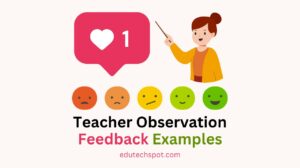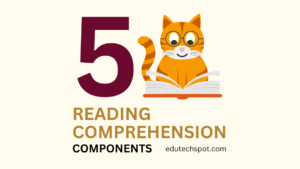sample positive comments for teacher observations. Teacher observation is a crucial way to improve the quality of education in schools. Observing teachers in action helps identify areas of strength and areas that need improvement. However, as an observer, it’s essential to provide constructive feedback that encourages growth and development rather than discouraging it. This is where positive comments come in. Positive comments are a powerful tool that can help teachers feel appreciated, motivated, and more willing to improve their performance. In this article, we will explore some effective teacher observation techniques, specifically focusing on the use of positive comments. We will discuss how to give feedback that inspires and encourages teachers to continue growing and improving, and how to create a positive, growth-oriented culture in your school. Whether you’re a school administrator, a teacher, or an educational consultant, these techniques will help you get the most out of your teacher observation process.
Traditional Teacher Observation Techniques
Traditionally, teacher observation involved a checklist of performance indicators that observers would use to evaluate the teacher’s performance. These checklists were often rigid and inflexible, and focused primarily on identifying areas of weakness. Observers would rate the teacher’s performance on a scale of 1-5 or 1-10 for each performance indicator, with a score of 3 or lower indicating an area that needed improvement.
While traditional teacher observation techniques can be useful in identifying areas of weakness, they have several limitations. First, they do not take into account the context in which the teacher is teaching. This means that a teacher may receive a low score on a performance indicator simply because of the nature of the lesson or the students in the class. Second, they do not provide any feedback on areas of strength. This means that teachers may not receive recognition for the things they are doing well, and may become demotivated as a result.
The Limitations of Traditional Techniques
One of the major limitations of traditional teacher observation techniques is that they focus solely on identifying areas of weakness. This can be demotivating for teachers, as they may feel that they are constantly being criticized and evaluated on their shortcomings rather than being recognized for their strengths. Additionally, traditional techniques may not take into account the context in which teachers are teaching, which can lead to inaccurate evaluations.
Another limitation of traditional techniques is that they may not provide teachers with actionable feedback that they can use to improve their performance. For example, simply telling a teacher that they need to improve their classroom management skills is not helpful. Instead, observers should provide specific examples of what the teacher did well and what they can improve on, and provide suggestions for how to improve in those areas.
The Benefits of Using Positive Comments
Positive comments are a powerful tool that can help teachers feel appreciated, motivated, and more willing to improve their performance. By focusing on areas of strength rather than weakness, positive comments can help build teachers’ confidence and encourage them to continue growing and improving.
Positive comments can also help create a positive, growth-oriented culture in schools. When teachers receive positive feedback, they are more likely to share their successes with their colleagues and be open to feedback from others. This can lead to a collaborative and supportive environment where teachers feel comfortable sharing their ideas and working together to improve their teaching skills.
Positive Comment Techniques for Effective Teacher Observation
When providing feedback to teachers, it’s essential to use positive comments that highlight areas of strength and provide actionable feedback for improvement. Here are some positive comment techniques that can be used for effective teacher observation:
1. Start with a positive comment. Begin by highlighting something that the teacher did well. This can be something as simple as “I noticed that you did a great job engaging your students in the lesson today.”
2. Be specific. Provide specific examples of what the teacher did well and what they can improve on. For example, “I liked the way you used real-life examples to illustrate the concept. However, I noticed that some students were having trouble following along. Perhaps you could try breaking down the concept into smaller parts to make it easier to understand.”
3. Provide actionable feedback. Give the teacher suggestions for how they can improve their performance. For example, “Next time, you could try using more visual aids to help students understand the concept better.”
4. Be supportive. Use positive language and tone to encourage the teacher to continue growing and improving. For example, “I know you have the skills and knowledge to be an excellent teacher, and I’m here to support you every step of the way.”
The Role of Feedback in Teacher Observation
Effective teacher observation relies heavily on feedback. Feedback provides teachers with a clear understanding of what they are doing well and what they need to improve on. It also helps them identify areas where they may need additional support or training.
Feedback should be ongoing and provided in a timely manner. Observers should provide feedback as soon as possible after the observation, while the lesson is still fresh in the teacher’s mind. This allows the teacher to reflect on their performance and make any necessary adjustments before their next lesson.
The Importance of Collaboration in Teacher Observation
Collaboration is essential for effective teacher observation. Observers and teachers should work together to identify areas of strength and weakness, and develop a plan for improvement. This can be achieved through regular meetings and discussions, where teachers can share their experiences and receive feedback from their peers.
Collaboration can also help create a positive, growth-oriented culture in schools. When teachers work together to improve their teaching skills, they are more likely to be open to feedback and willing to try new approaches. This can lead to a more innovative and effective education system.
Implementing Positive Comment Techniques in Your School or Classroom
Implementing positive comment techniques in your school or classroom requires a collaborative approach. Observers and teachers should work together to develop a system for providing feedback that focuses on areas of strength and provides actionable feedback for improvement.
Some ways to implement positive comment techniques include:
1. Providing training for observers on how to use positive comments effectively.
2. Encouraging teachers to share their successes with their colleagues.
3. Creating a culture of collaboration and support in your school or classroom.
4. Providing ongoing feedback and support to teachers.
Measuring the Success of Positive Comment Techniques
Measuring the success of positive comment techniques can be challenging. However, there are several ways to evaluate the effectiveness of these techniques, including:
1. Conducting surveys to gather feedback from teachers on the usefulness of positive comments.
2. Reviewing student performance data to see if there has been an improvement in academic outcomes.
3. Conducting follow-up observations to see if teachers have made improvements based on the feedback they received.
Conclusion
Effective teacher observation is essential for improving the quality of education in schools. By using positive comments, observers can provide teachers with constructive feedback that encourages growth and development. Positive comments can help create a positive, growth-oriented culture in schools, where teachers feel supported and motivated to continue improving their teaching skills. By implementing positive comment techniques in your school or classroom, you can help create a more innovative and effective education system.




